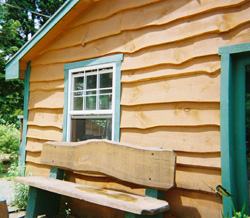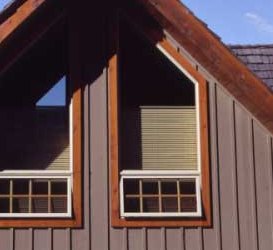 Wood siding is a classic way to provide both beauty and protection to a home, bringing a warm, traditional feel. In order to preserve the beauty of natural wood, the exterior coating of paint or stain must be regularly maintained. This prevents moisture entry, wood rot and pest entry, keeping your home looking its best. The question that many homeowners have is whether to use paint or stain when their home needs attention.
Wood siding is a classic way to provide both beauty and protection to a home, bringing a warm, traditional feel. In order to preserve the beauty of natural wood, the exterior coating of paint or stain must be regularly maintained. This prevents moisture entry, wood rot and pest entry, keeping your home looking its best. The question that many homeowners have is whether to use paint or stain when their home needs attention.
Paints vs. Stains
When speaking of paints versus stains, it is important to differentiate the types a little more. Solid-color stains are almost identical to regular paint, since they both form a layer on the surface of the wood, rather than penetrating the wood. These both come in just about any color, and provide the longest and most thorough protection for wood siding. The advantage to stain is that it will expand and contract more with the wood, enduring the changing weather better. Stain is also more breathable, allowing natural airflow through the wood. Paint will dry in a thicker coat, providing a more substantial barrier.
Semi-transparent stains actually sink into the wood, coloring the wood fibers and enhancing the natural character of the grain. These do not provide as much UV and moisture protection, and they do not last as long, but they are not expensive. If your semi-transparent stain is beginning to look shabby, a new coating can be added with minimal preparation, unlike paint and solid-color stains.
Which Product should I use?
 For existing homes, the simplest answer is to use the same product that was previously applied, whether paint or stain. This is especially the case if your home currently has painted siding, since it requires a lot of sanding and priming to stain previously painted wood. If your home was previously stained, switching to paint is not very labor intensive.
For existing homes, the simplest answer is to use the same product that was previously applied, whether paint or stain. This is especially the case if your home currently has painted siding, since it requires a lot of sanding and priming to stain previously painted wood. If your home was previously stained, switching to paint is not very labor intensive.
On new homes, the product you choose should be based on your goals for how it will look and how often it will need maintenance. To get the most out of the natural character of the wood, use semi-transparent stain. If you want a solid color and longer protection, use solid-color stain for lower maintenance, or paint for a heavier barrier.
Questions? Need Additional Tips and Resources?
If you have any questions you’d like answered here, ask us via twitter or Facebook.